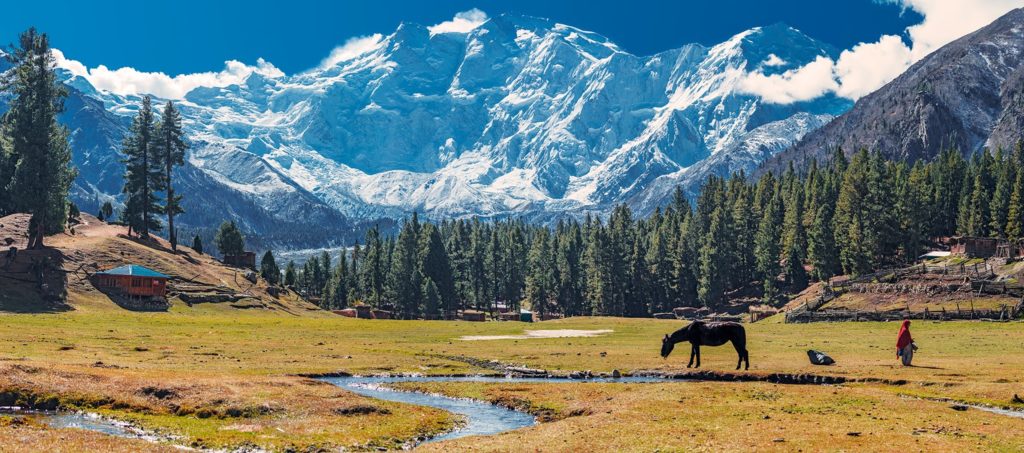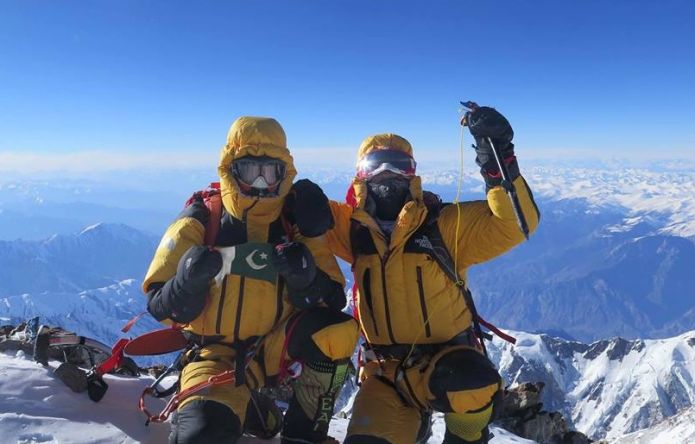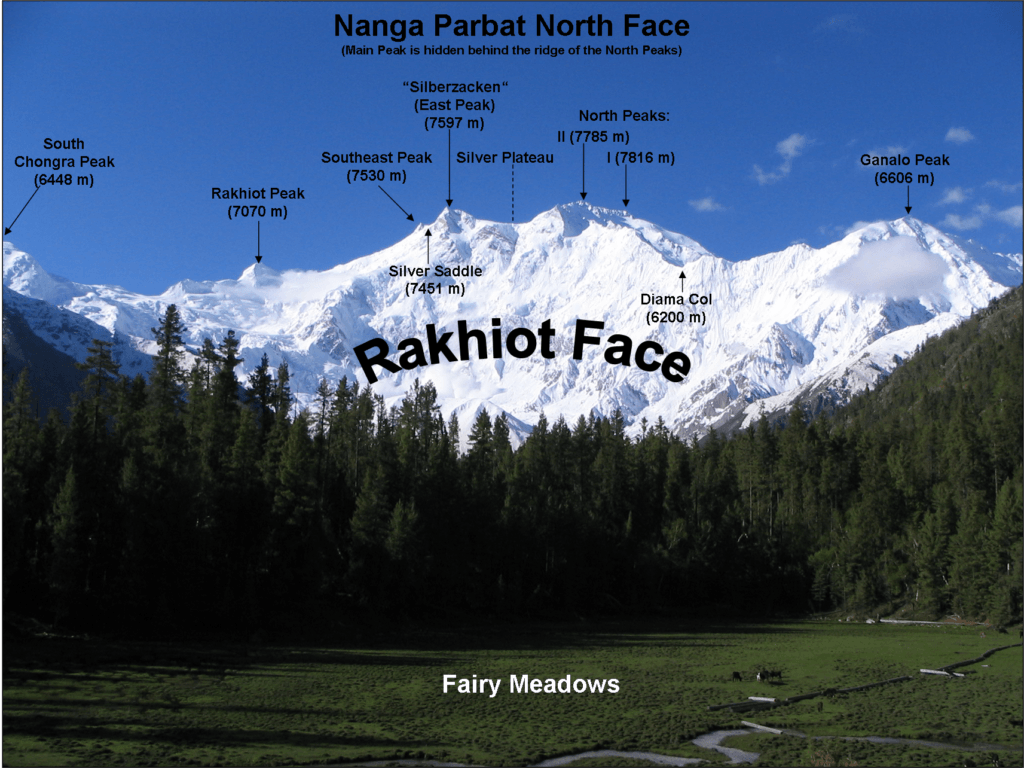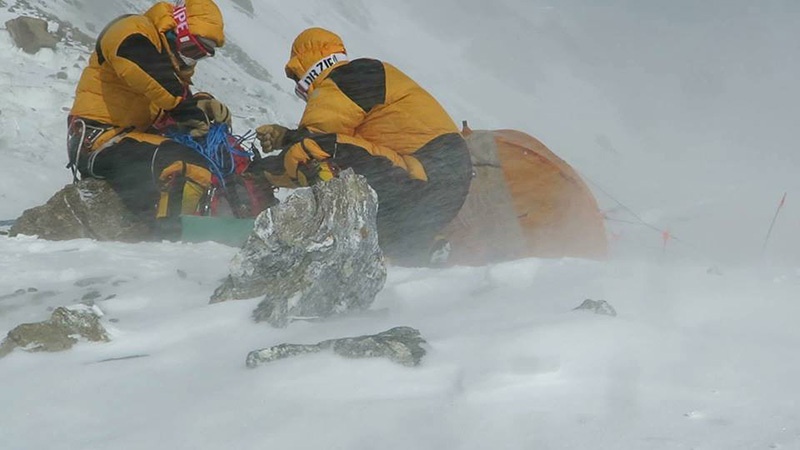Nanga Parbat is one of the eight-thousanders. Eight-thousanders are those mountains whose height is more than 8,000 metres (26,247 ft) above sea level, and are considered to be sufficiently independent from neighbouring peaks).
An immense, dramatic peak rising far above its surrounding terrain, Nanga Parbat is also a notoriously difficult to climb. In the mid and early-20th century, a large number of mountaineering deaths were recorded here that lent this peak, the nickname “Killer Mountain.”

The mountain of Nanga Parbat is locally known as Diamer. It is the ninth highest mountain of the world and second highest in Pakistan. The worlds highest mountain is Mount Everest which is located in Nepal whereas the highest mountain of Pakistan is K2, it is also the worlds second highest mountain.
The height of Nanga Parbat is 8,126 metres (26,660 ft) above sea level. It is located in the Diamer District of Pakistan’s Gilgit Baltistan region, Nanga Parbat is the western anchor of the Himalayas. Himalaya form a mountain range in Asia, separating the plains of the Indian subcontinent from the Tibetan Plateau.

The name “Nanga Parbat” has been derived from the Sanskrit words nagna and parvata which together mean “Naked Mountain”. Locally the mountain Nanga Parbat is known by its Tibetan name Diamer or Deo Mir, meaning “huge mountain”.
The core of Nanga Parbat is a long ridge trending southwest–northeast. The ridge is an enormous bulk of ice and rock. It has three faces, Diamir face, Rakhiot, and Rupal. The southwestern portion of this main ridge is known as the Mazeno Wall, and has a number of subsidiary peaks. In the other direction, the main ridge arcs northeast at Rakhiot Peak (7,070 m or 23,200 ft). The south/southeast side of the mountain is dominated by the Rupal Face. The north/northwest side of the mountain, leading to the Indus, is more complex. It is split into the Diamir (west) face and the Rakhiot (north) face by a long ridge. There are a number of subsidiary summits, including North Peak (7,816 m or 25,643 ft) some three kilometres (1.9 mi) north of the main summit. Near the base of the Rupal Face is a glacial lake called Latbo, above a seasonal shepherds’ village of the same name.

Soon after the discovery of Nanga Parbat by Europeans, the first attempts to summit Nanga Parbat was undertaken in 1895 by Albert F. Mummery who led an expedition to the peak. He managed to reach almost 6,100 m (20,000 ft) on the Diamir (West) Face but Mummery and two Gurkha companions later died reconnoitering the Rakhiot Face.
Nanga Parbat summit Video
Later, a lot of mountaineers tried to summit Nanga Parbat but they didn’t succeed until July 3, 1953 when an Austrian climber Hermann Buhl, a member of a German-Austrian team successfully ascended the summit via the the Rakhiot Flank (East Ridge).
The Nanga Parrbat expedition was led Peter Aschenbrenner from Kufstein, who had participated in the 1932 and 1934 attempts. By the time of this expedition, 31 people had already died on the mountain.

The final push for the summit was quite dramatic: Hermann Buhl continued his journey all alone for the final 1,300 metres (4,300 ft), as his companions had turned back due to the extreme weather conditions and consequences. He reached the summit dangerously late, at 7:00 p.m., the time when climbing is way too harder and consumes more time. He is the only man to have made the first ascent of an 8,000-metre (26,000 ft) of Nanga Parbat all alone. The ascent was made without any use of oxygen.
In 1984 the French climber Lilliane Barrard became the first woman to climb Nanga Parbat, along with her husband Maurice Barrard.
Nanga Parbat was first successfully climbed in winter on February 26, 2016, by a team consisting of Ali Sadpara, Alex Txikon, and Simone Moro.

During the Nanga Parbat summit. Photo: Simone Moro 
At the summit of Nanga Parbat. Photo: Simone Moro

The first ascent of Nanga Parbat via the Mazeno ridge
Climbing mountains is not an easy task, it takes a lot of guts to do so. So many people have sacrificed their lives to summit world highest mountains. Keep in mind, all the odd, such as extreme weather conditions, modern equipment, technology, death, don’t stops us from going further. We the mountaineers have a curiosity to experience things by our self and we love to challenge our limits.































